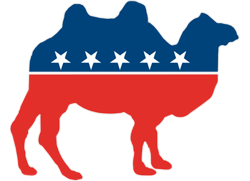
America's oldest 'third party, the Prohibition Party, has been striving since 1869 to enhance the freedom and dignity of the individual and to protect the welfare of the family. We're interested in many problems which directly impact the home: debt, gambling, job insecurity, trivialized education, spouse and child abuse, intrusive governmental regulations, drinking, and more. We're interested in helping people help themselves by voluntary association in a private enterprise economy. We're interested in teaching personal responsibility. We're Americans, original, old, and new, who love our country and what it stands for.
When you vote for the 'lesser of two evils,' that's exactly what you get. But, when Prohibition Party candidates earn large protest votes, major party politicians notice. When we join together and vote our consciences, we do make a difference. If your state election officials do not recognize the Prohibition Party, then register in another and influence that party by voting in its primary, but please support the Prohibition Party with your gifts and vote for Prohibition Party candidates at the general election.
If you are a reform-minded conservative and a non-drinker, the Prohibition party wants you!
Who Are We?
Earl Dodge conducted a mail survey of members' religious affiliations early in 1970. There were 134 responses. Ninety-two percent of those were Protestant (Methodist, Baptist, Free Methodist, and Nazarene were the four commonest denominations, being 54% of the Protestants). There were at least one Roman Catholic and one atheist.
Prohibition Party Platforms
- Click here for The Prohibition Party Platform as adopted by the 2020 convention
- Other Party Platforms
Legal Documents

The 34th quadrennial convention of the Prohibition National Committee resolved to discontinue publishing The National Statesman. In its place, the Prohibition National Committee now publishes The National Prohibitionist.

Our Logo, the Camel
Influential political cartoonist Thomas Nast (1840-1902), he who gave the pachyderm to be the symbol of the Republican Party and the jackass for that of the Democratic Party, also gave the camel to the Prohibition Party. Nast drew for Harper's Weekly during the last quarter of the nineteenth century.
Nast chose the camel to represent the Prohibition Party because, like Prohibitionists generally, camels don't drink very often, and, when they do drink, they drink only water. Originally a dromedary, the symbol was later changed to the Bactrian camel in order not to be associated with the camel logo on Camel Cigarettes.
What About Those Bible Wines?
One of the most vexing disagreements between alcohol prohibitionists and moderationists concerns the use of the word 'wine' in the Bible. Each side quotes its own favorite verses of Scripture to justify its own viewpoint. And taken literally, the King James Version and most other translations do contradict themselves about 'wine.'
The issue can be resolved in one of two ways:
1. People who reject the doctrine of Biblical Inspiration consider the Bible to be a collection of oral traditions derived from several Middle Eastern societies. Some of these societies approved of drinking, others did not. The contradictions among the Bible sources are therefore real but are of no consequence.
2. People whose faith tells them that the Bible was inspired consider the contradictions to be only apparent (not real) and explain them away as errors in interpretation. The word 'wine' in olden times was used indiscriminately to mean either fresh grape juice or fermented (alcoholic) grape juice. The context in which the word is used tells the reader which meaning is appropriate.
American English today uses the word 'cider' in the same way—'cider' can be either fresh apple juice (sweet cider) or fermented apple juice (hard cider). The context in which the word is used tells the reader which meaning to infer.
Two excellent books on the subject of Bible wines are Stephen M. Reynolds The Biblical Approach to Alcohol (US Council International Organization of Good Templars) and Charles Wesley Ewing The Bible and its Wines (Prohibition National Committee).
--Editor
National Committee of the Prohibition Party
Alabama
Rev.. John Killian, Fayette
Georgia
Billy Joe Parker, Waleska
Illinois
Richard D. Swift, Monmouth
Maine
Ray Perkins, Jr., Waldoboro
Maryland
Raymond E. Edwards, Lexington
Massachusetts
Adam Seaman, Southwick
New York
Russell Hallock, Washingtonville
Jonathan Makeley, Amherst
Ohio
James Coleman, Youngstown
Pennsylvania
Barry Alfonso, Pittsburgh
Texas
Tony Mathison, Wichita Falls
Executive Committee
The National Committee of the Prohibition Party designates a seven-member executive committee, which makes any necessary policy decisions between national conventions. Day-to-day operating decisions are made by the Chairman. The Executive Committee includes (as of 9 March 2025):
Chairman -- Zack Kusnir, New York
Vice-Chairman -- Carl Moore, Ohio
Secretary -- Jon Makeley, New York
Treasurer -- Zack Kusnir, New York
Members -- Russell Hallock, New York
John Pietrowski, Ohio
About National Committeemen
Each of the 50 states is entitled to two representatives on the National Committee. There are many vacancies in the above list. If you or someone you know would like to fill one of those vacancies, please contact the Prohibition National Committee.
"Let us not grow weary while doing good, for in due season we shall reap if we do not lose hear
- Galations 6:9(NKJV)
